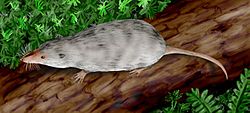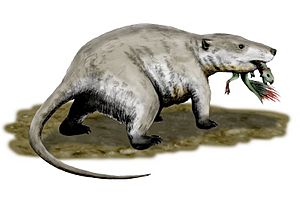Mammaliaforms facts for kids
Quick facts for kids MammaliaformesTemporal range: Upper Triassic–Recent
|
|
|---|---|
 |
|
| Adelobasileus | |
| Scientific classification | |
| Kingdom: | |
| Phylum: | |
| Subphylum: | |
| (unranked): | |
| Class: | |
| Order: | |
| Suborder: | |
| (unranked): |
Mammaliaformes
Rowe, 1988
|
Mammaliaformes (say "Mam-MAY-lee-uh-form-eez") means "mammal-like." This group includes all living mammals and their closest relatives that are now extinct. Think of it like a big family tree where all mammals and their ancient cousins belong.
The mammals alive today are part of this group. They include:
- Monotremes: These are unique mammals that lay eggs, like the platypus and echidna.
- Marsupials: These mammals carry their babies in a pouch, like kangaroos and koalas.
- Eutherians: These are also called placental mammals. Their babies develop inside the mother using a placenta, like humans, dogs, and elephants.
Mammaliforms have special teeth called molars. These teeth have bumps (cusps) and flat areas. This design helps them grind food very well. Unlike many animals that replace their teeth often, mammals usually have just two sets of teeth: baby teeth and then adult teeth. These adult teeth fit together perfectly, which makes chewing and digesting food much easier.
Other important features of Mammaliaformes include having fur or hair and producing milk (lactation) to feed their young. While these traits are hard to see in old fossils, scientists have found amazing clues, like the fossil of Castorocauda lutrasimilis, which showed signs of fur.
Contents
How Early Mammals Evolved
For a long time, scientists didn't have many fossils of early mammals from the Mesozoic Era (the time of dinosaurs). In 1979, there were only about 116 known fossils. But this has changed a lot! By 2007, over 300 fossils had been found. Many of these are nearly complete skeletons, giving us a much better look at these ancient creatures.
Different Lifestyles of Ancient Mammals
People used to think that all early mammals were small, active at night, and ate insects. While some were like that, new fossil discoveries show that these ancient mammal relatives had many different ways of life. They adapted to various environments and diets.
Castorocauda: The Ancient Swimmer
Castorocauda was an amazing mammal relative that lived about 164 million years ago. It was about 42.5 cm (16.7 inches) long and weighed between 500 to 800 grams (about 1 to 1.7 pounds). Its body was built for swimming and digging, and its teeth were perfect for eating fish. Another animal from the same group, Haldanodon, also liked water. It seems many animals in this group lived in wet, swampy places.
Repenomamus: A Dinosaur Hunter
Repenomamus lived about 130 million years ago. It was a strong, badger-like hunter. Scientists have even found fossils showing that Repenomamus sometimes ate young dinosaurs! Two types of Repenomamus have been found, with the largest one being over a meter (about 3 feet) long. This shows that not all early mammals were tiny.
Other Cool Ancient Mammals
- Multituberculates: These creatures lived for a very long time, over 125 million years! They are often called the "rodents of the Mesozoic" because they might have filled a similar role. They may have given birth to tiny live babies instead of laying eggs.
- Fruitafossor: This mammal relative, from about 150 million years ago, was about the size of a chipmunk. Its teeth and strong front limbs suggest it dug into nests of social insects, like termites, to find food.
- Spinolestes: This animal also had features for digging. It might have eaten insects like an anteater. What's really cool is that it had quills, just like modern spiny mice!
- Volaticotherium: From about 125 million years ago, this is the earliest known gliding mammal. It had a membrane of skin between its limbs, much like a modern flying squirrel. This suggests it was active during the day, unlike many early mammals.
- Ichthyoconodon: Scientists found its teeth in ancient ocean deposits. These teeth were sharp and pointed, similar to those of mammals that eat fish. This suggests Ichthyoconodon was one of the very few marine (ocean-dwelling) mammals known from the Mesozoic Era.
These discoveries paint a picture of early mammals being quite successful and diverse during the time of the dinosaurs. They weren't just small, shy creatures; they had many different roles in their ancient ecosystems.
How Scientists Classify Mammals
Sometimes, the group "Class Mammalia" is used to include all the animals that are part of Mammaliaformes. It's like saying "dogs" instead of "Canis familiaris" – a simpler way to talk about the same group.
Here's a simplified way scientists group some of these ancient mammal relatives:
- MAMMALIAFORMES
- Branch Allotheria
See also
 In Spanish: Mammaliaformes para niños
In Spanish: Mammaliaformes para niños


